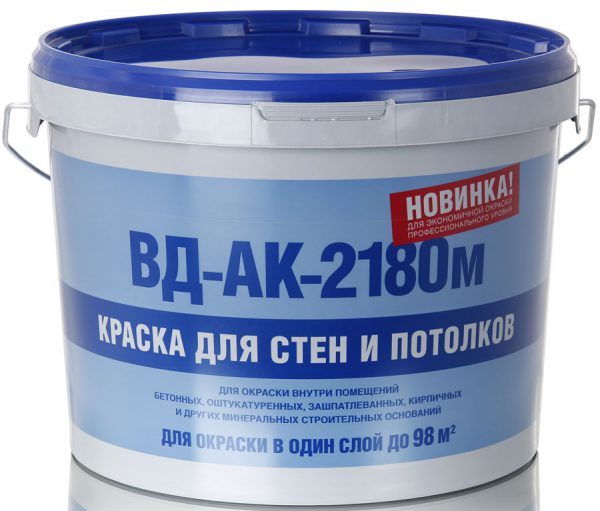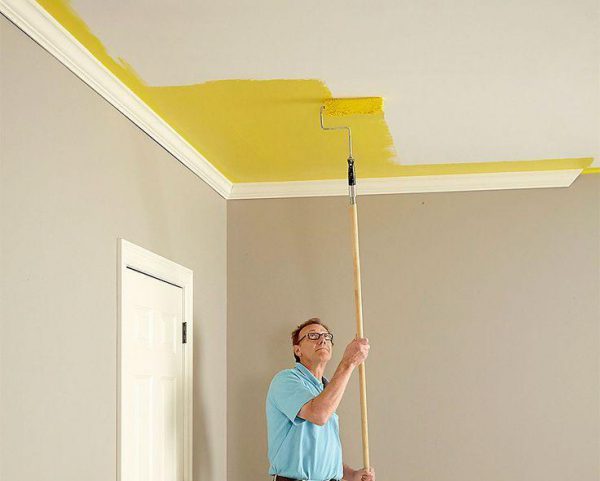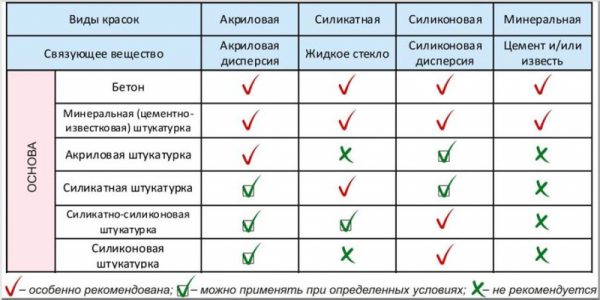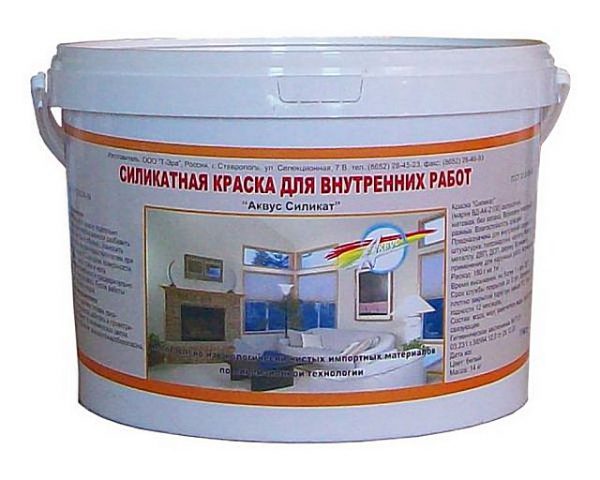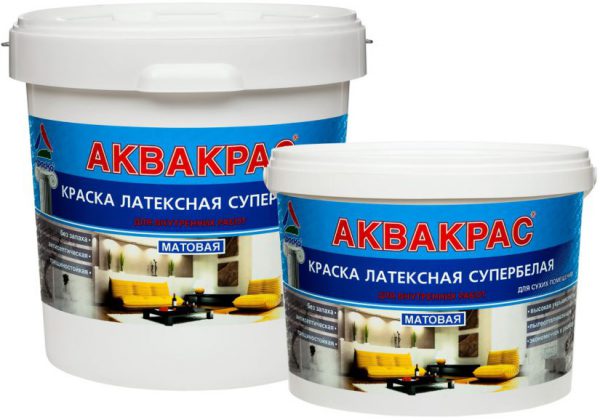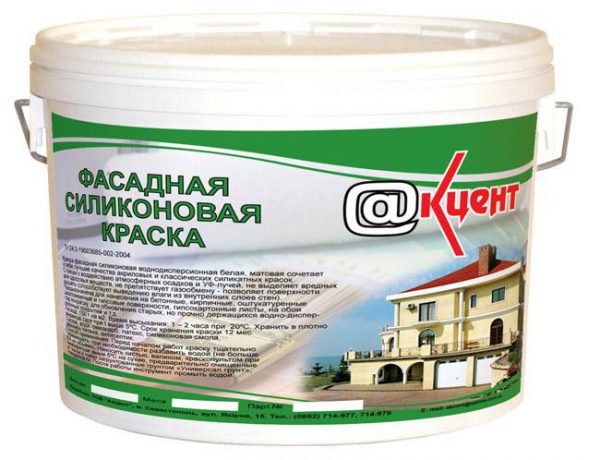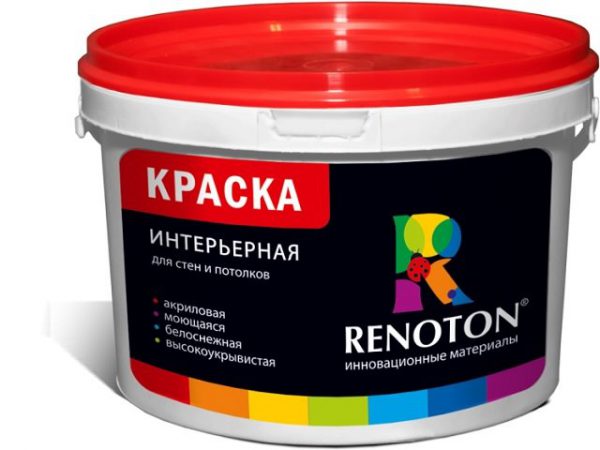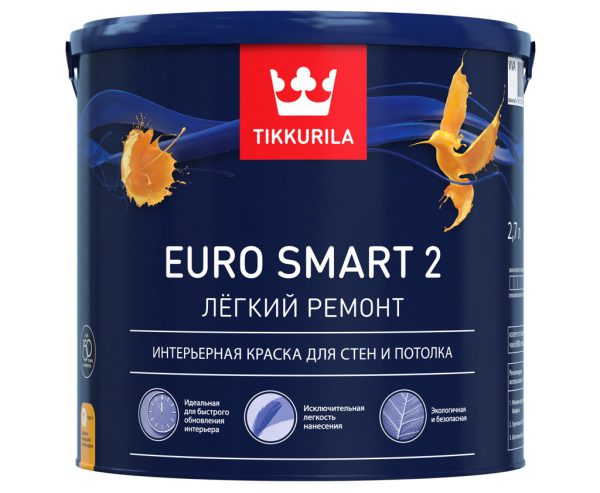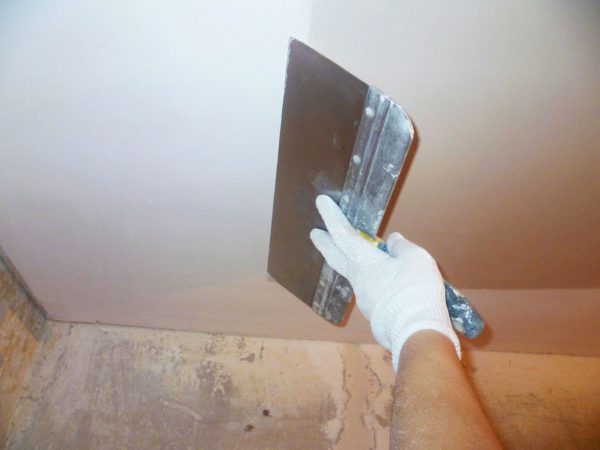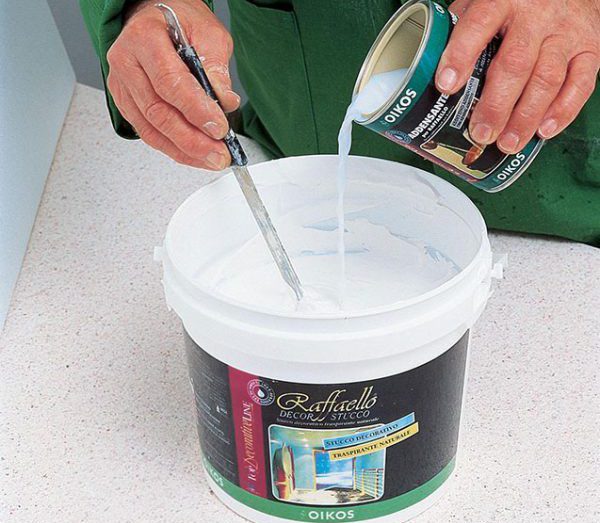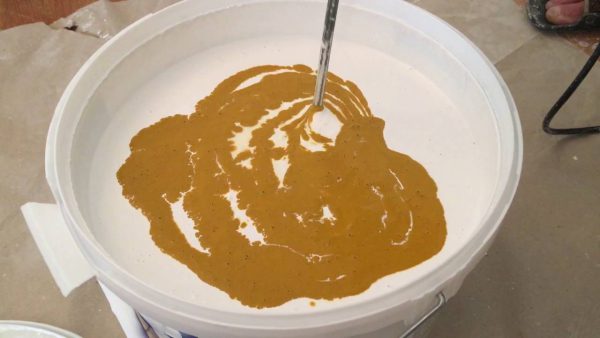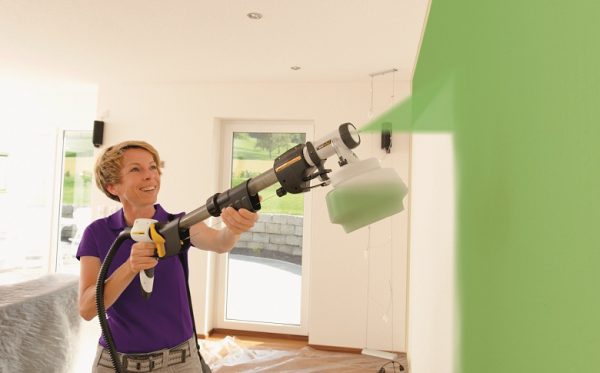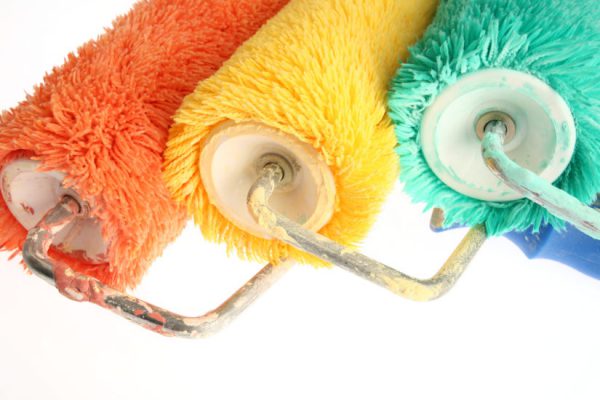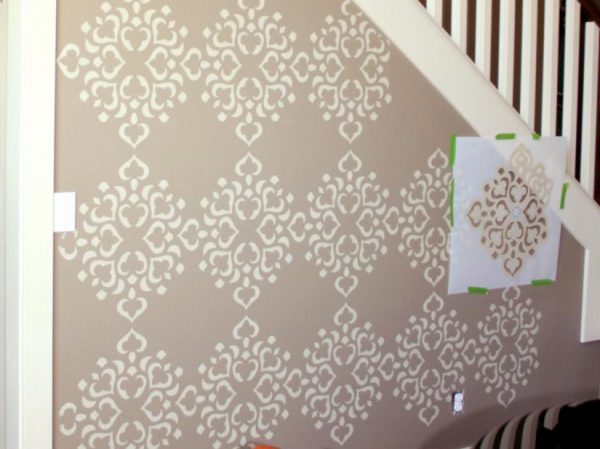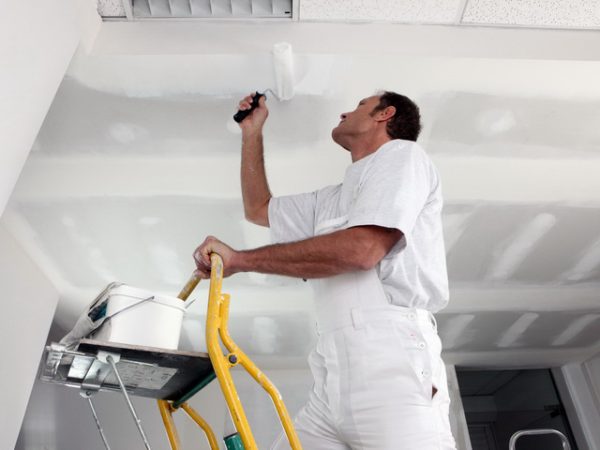Water-based paint for walls and ceilings is still very popular during repairs. The reason for this is its affordability and numerous functional advantages.
- Specifications
- Proportions of components
- Marking
- Advantages and disadvantages
- Varieties of paint
- Polyvinyl acetate
- Mineral
- Silicate
- Acrylic
- Latex
- Silicone
- Classification of paints by purpose and type of coating
- Popular manufacturers
- Surface preparation
- Surface cleaning
- Closing slots
- Paint preparation
- Paint dilution
- Tinting
- Paint consumption
- Instruments
- Paint application
- Decorative painting
- Top Questions
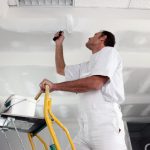
Specifications
The following factors are important for the description of the aqueous emulsion composition:
- Paint components. In an aqueous solution can be a variety of fillers, thickeners, antiseptic substances. Depending on the composition, the paint is intended for facade or interior work, wet or dry rooms, etc.
- Scope of use. The composition can be universal or for coloring only one type of surface (for example, wood).
- Consumption of paintwork. Calculate the amount of paint in milliliters, based on how much it will take to cover 1 square meter in one layer. At the same time, many factors are taken into account, including the type of material and surface condition.
- Specific gravity. High-quality water-dispersion paint has a density of approximately 1.5 kg per 1 liter.
- Viscosity. This parameter indicates the degree of dilution with the liquid.
- Humidity during application and use.
- Drying time.
- Storage conditions.
- Shelf life.
- The life of the coating.
Other technical details should be known, including proportions of paint components and common markings.
to contents ↑Note! Water-based paint is always white, and color is obtained by adding special pigment.
Proportions of components
An important component of water-based paints is the emulsifier, which is responsible for the formation of the film.
The following components are used as film formers:
- styrene butadiene;
- acrylic resin;
- polyvinyl acetate;
- styrene acrylate.
Also, mica, barite, talc, chalk are added to the composition. The proportions in which these or those components are contained in the paint are determined by its purpose.
The function of the thickener is performed by a complex compound - carboxymethyl cellulose. In everyday life, this component is called the adhesive composition of CMC.
Note! For work with emulsion paint it is recommended to use a spray gun. Spraying allows you to get the most high-quality and uniform coating.
The table shows the ratio of various components in water-based paint:
Aqueous emulsion paints and varnishes are made by adding a white pigmenting agent, for example zinc oxide or titanium dioxide.
According to the main component, all water-based dyes are divided into several types:
- silicate;
- acrylic;
- silicone;
- mineral.
Marking
Abbreviated alphanumeric characters are used on the paint can or in accompanying documents. First come the letters suggesting the type of composition:
- VE - water-based paint;
- VD - water-dispersion.
The following letters indicate the type of polymer used:
- CN (butadiene-styrene);
- VA (polyvinyl acetate);
- AK (acrylate or styrene acrylate);
- BC (polyvinyl alcohol).
In addition to letters, numbers are used:
- 1 - compositions especially resistant to atmospheric phenomena;
- 2 - paints for interior work.
to contents ↑Note! Requirements for water-based coatings are described in GOST 281960-89. Unlike GOST, TU rules are much less stringent, and therefore the quality of products manufactured according to TU cannot be guaranteed.
Advantages and disadvantages
Water-based paints have many positive qualities:
- Good adhesion with different types of materials.
- Ease of dilution in water.
- Environmental Safety.
- Fast drying.
- No odor in the room after painting the surface.
- Strength. The coating does not peel.
- Resistance to chemicals, including alkalis.
- Easy to remove dirt from the coating.
- Fire safety.
- High water resistance of individual modifications, which allows them to be painted with surfaces in bathrooms and kitchens.
- Antibacterial properties.
- Long life of the coating, reaching 18-20 years.
- The ability to mask surface defects (with the proper level of viscosity of the composition).
- Compatibility with any type of interior. Thanks to tinting, the paint has a wide palette of colors.
- Low cost.
There are water-dispersed paints and cons:
- Sensitivity to temperature when staining. The minimum threshold is 5 degrees above zero.
- Certain varieties of paints form not very durable surfaces.
- Not all water-based formulations are suitable for metal substrates or glossy surfaces.
Varieties of paint
There are several types of water-based paints and varnishes.
Polyvinyl acetate
Most affordable. The advantages also include resistance to ultraviolet and grease contamination. These paints are non-toxic and fireproof. However, polyvinyl acetate dyes are unstable to moisture, and over time, their coatings turn yellow.
Mineral
Contain calcium hydroxide and cement. The main advantage of mineral coatings is also low cost. Best suited for painting concrete and brick. They are characterized by increased vapor permeability and resistance to temperature extremes. However, coatings quickly change in color and are unstable to mechanical damage.
Silicate
The main component is liquid glass. Advantages: affordability, durability, mechanical strength, resistance to temperature extremes and vapor permeability. Disadvantages: suitable only for painting concrete and plaster in rooms, as they are unstable to moisture. In addition, silicate coatings do not lie at all on metal and glass surfaces.
to contents ↑Acrylic
Acrylate based paints are the most popular today. Differ in universality, they can be painted any type of surface. However, prior to painting the metal, high-quality priming is required. Advantages: resistance to ultraviolet, mechanical stress, dirt-repellent properties, elasticity. An important quality of acrylic paints is a low consumption rate. Another advantage: the washable surface painted with acrylic paint is equally well used both outdoors and indoors.
to contents ↑Latex
This type of coatings contains latex. In this regard, the cost of paints is high. Latex gives the coating excellent moisture resistance. Such surfaces can be washed even with aggressive detergents. Latex paints are suitable for all types of surfaces.A characteristic feature of latex solution is the ability to mask surface imperfections.
A significant drawback of latex paint is the lack of vapor permeability, and therefore condensation appears on the coating. In addition, latex is not resistant to subzero temperatures, ultraviolet and fungus.
to contents ↑Silicone
The main component is silicone silicone resins. Especially often used when painting ceilings. This is due to the good adhesion of the paint, so that no drips form on the ceiling during the painting process.
Due to its high viscosity, silicone paint masks small surface defects. This basis allows you to achieve an antiseptic effect, high vapor permeability, resistance to chemicals and fungal formations. In this regard, coatings are popular for finishing wet rooms.
Due to their excellent adhesive characteristics, silicone formulations are often applied to old paint layers. The high density and hiding power of the material allows you to dispense with a couple of layers even when painting a black surface.
to contents ↑Classification of paints by purpose and type of coating
Aqueous emulsion compositions are distinguished by purpose (information on this is contained on the label):
- For dry rooms with low operational load. Such paints are not suitable for wet rooms. This type of water emulsion is not the best option for children, as the coating cannot be washed.
- Resistance to mechanical stress. A similar marking is used for paints and varnishes that form abrasion-resistant coatings, but are afraid of moisture. The surface may only be cleaned with a dry brush or vacuum cleaner, but not with water.
- Indelible coating. Paints with this marking are used in rooms with a high level of humidity or in rooms where there is a need for frequent wet cleaning. However, do not work too hard with a damp cloth, as the coating does not have abrasion resistance.
- Dirt repellent. Coatings of this type are among the most durable, well tolerating wet cleaning even with the use of harsh chemicals. You can choose a dirt-repellent paint if you intend to use the coating in conditions of high humidity or with constant pollution.
- Interior. Paint is marked with the word "interior" if it is intended for use only inside the building.
- For the ceiling. The peculiarity of ceiling paint is that it has a more fluid consistency compared to coatings for walls or floors.
There are three types of coatings:
- Glossy. The shiny surface allows you to visually increase the space, create the feeling of a high ceiling. Glossy coatings are not afraid of wet cleaning and are resistant to abrasion. However, any defects (cracks, chips, etc.) are noticeable on them.
- Frosted. Unlike glossy, matte coatings do not tolerate wet cleaning. However, against a matte background, small surface imperfections are almost invisible.
- Semi-matte. This type of coating is a cross between matte and glossy.
Popular manufacturers
There is a wide variety of aqueous emulsion formulations on the market. The best quality products are produced by such European manufacturers as Tikkurila, Dulux and Dufa. The products of famous brands are expensive, but have excellent consumer characteristics and a proven reputation. Inexpensive paints of little-known companies are not always a synonym for low quality, but it is recommended to study reviews of such products on the Internet before buying.
to contents ↑Surface preparation
To paint well adhered to the base coat, it must be carefully prepared. We are talking about removing bumps, repairing cracks and cleaning the surface of dirt and dust.
to contents ↑During the preparatory work, a considerable amount of garbage can occur, and when painting, it is easy to stain surrounding interior items.To avoid damage to property, use a plastic film that is attached to the skirting boards with masking tape.
Surface cleaning
First you need to clean the walls of old paint or any other decorative coating. To remove paint use one of three methods:
- Mechanical.
- Chemical.
- Thermal.
Note! The coating based on oil paint is incompatible with water-based coatings, so it will have to be removed in any case. If the old paint is enamel, it can be left, but the surface can be primed with a drying oil.
Standard steps for surface cleaning:
- Remove the old coating with a hard sponge or brush.
- If the wall is whitened, wet it with water and remove the rest of the whitewash with a brush or ordinary sponge.
- If we are talking about oil paint, we use a building hair dryer to heat the coating - the only way it can be softened and removed with a scraper or spatula.
Commercially available products for chemical cleaning of the surface from old paint. Such chemicals destroy the previous coating, so that after some time after their application it remains only to remove the paint residues mechanically.
to contents ↑Closing slots
When the walls are cleaned, we begin to search and repair cracks in the base coat. If you ignore this work, you will not be able to get a stable new coating and new cracks will inevitably appear on the painted surface.
Found cracks slightly expand to fill them with a repair composition, using a spatula or grinder. Next, we clean the cracks from dust and apply a primer for painting deep penetration. Allow the material to dry (most often we are talking about 4-6 hours of waiting).
The next step is to seal the cracks with a putty compound or some kind of polymer (for example, silicone sealant). To prepare the putty, we use an electric drill with a mixer nozzle. The composition must be brought to complete homogeneity, only then it is considered ready.
After drying the putty, the walls are once again treated with a primer. Once again, wait for the surface to dry before continuing.
to contents ↑Paint preparation
Paint dilution
The paint in the jar has a thick consistency. The undiluted composition is great for creating relief compositions, but for regular painting is too thick. In this regard, the emulsion is first thoroughly mixed, and then water is added to it. The quantity is determined based on the recommendations of the manufacturer or empirically. Water is added until the coatings obtain the desired consistency. Correctly diluted paint resembles fat milk in density.
If you plan to use a spray gun, tap water will not work, because after drying the coating a whitish coating forms on it. In this regard, distilled water or alcohol is used for dilution.
Paint should be diluted immediately before use. Already after 15-20 minutes, the composition thickens. If this time is missed, the paint should be diluted again.
to contents ↑Tinting
Aqueous emulsion composition is offered in white. If you want to give the paint a different color, add pigment to it. This can be done at home or right in the store, if there is specialized equipment.
If you tint on your own, it is recommended to purchase pigment with a margin of 10-15%. This will allow in the future to easily recreate the composition for updating the coverage.
Kohler is added gradually, after which the solution is thoroughly mixed. If the intensity of the resulting shade does not suit, then you need to add more pigmenting substance.
First, a little tinted paint should be diluted, which will allow you to see how it will look on the painted surface. Moreover, the shade of the dried coating differs from the color of liquid coatings.You also need to keep in mind that paint with an improper shelf life or improper storage can have a significantly changed color (compared to the original) and adhere poorly to the surface. Low-quality paint forms a bubble coating or simply completely drains from the surface.
to contents ↑Paint consumption
The approximate consumption per m2 is indicated by the manufacturer on the bank. Based on these data, it becomes possible to plan paintwork consumption.
You can also calculate the amount of paint you need, based on the General consumption rates of water-based coatings:
However, it should be remembered that the consumption rate of 1 m2 of the same paint can vary greatly depending on additional factors. In particular, we are talking about the type of material to be painted. A smooth surface absorbs 15-20% less coatings in comparison with rough.
Note! In the calculations take into account the number of layers. Most often, to coat the surface of one layer is not enough - they will need at least 2-3.
Also, the tool used affects the material consumption. For example, the use of a spray gun can reduce paintwork consumption, but only if the painting is carried out in calm weather.
Consumption also depends on temperature and humidity. In hot weather, the liquid quickly evaporates from the dye, and therefore the coating is formed unevenly - you have to re-apply the layers. Additional paintwork losses are a common occurrence when painting the ceiling, since the composition simply drains down.
to contents ↑Instruments
For applying paint using brushes, rollers or spray guns. Brushes are the best option for processing small surfaces with many corners and convex parts. The spray gun is a convenient tool, but not everyone has it, and buying it for one painting is not always advisable. Therefore, the most often the best for painting the surface is a roller.
There are several types of rollers:
- Foam rubber. Differ in low cost. Too much dye is taken in, and therefore bubbles and irregularities form on the coating.
- Velor Buying them is more difficult due to less prevalence. Velor rollers are characterized by low absorbency. This property has a positive effect on the quality of painting, but it will be necessary to dip the roller very often.
- Fleecy. The best option for painting. On sale there are rollers with different pile lengths (affects the thickness of the layer). The most expensive fleecy rollers are made of felt and fur. Polyamide rollers are also a good choice.
Paint application
Prepared paint material is poured into the paint tray. To paint it was more convenient, reaching the most remote areas, a long handle is attached to the roller. In this quality, use a plastic tube or a light wooden holder.
Apply the paint from the corner of the wall. Moreover, it is stained with a brush. Then dip the roller in the paint, squeeze it on the pallet and make movements in the direction of down and then up. The thickness of the applied strip is equal to the width of the roller. Each subsequent strip is lapped with the previous one. In this way, the appearance of visible boundaries between the strips is avoided. You need to paint quickly in order to manage to work out all the diluted paintwork materials.
2-3 layers of a water-based composition are applied to the putty walls. Each time they wait until the coating dries, and only then begin to apply a new layer. On average, a break is 3-4 hours.
to contents ↑Note! When applying paint to the wallpaper, one layer is enough.
Decorative painting
If you wish, you can not just paint the wall or ceiling, but draw a picture or patterns. To do this, you need a figured roller, stencil and masking tape.
Note! Decorative painting is carried out after the base layer has dried.
With a figured roller they work the same as with a regular one. There is a wide variety of patterns and textures, for the selection of which it is enough to change the stencil. You can buy it in a store or make it yourself.An instruction is attached to the purchased stencil, which indicates the colors for all its segments.
Advice! When using a stencil, do not press it too hard to the surface, as this will result in leaks.
Masking tape will be needed to create geometric patterns. He closes that section of the wall, which currently does not need to be painted. Then the tape is removed and a layer of paint is applied to the freed surface. Thanks to the adhesive tape, it is possible to avoid getting paint on unwanted places. It is removed only after the paint coat has dried to prevent sagging.
to contents ↑Top Questions
- How to remove water-based paint? Aqueous emulsion ink can be washed off with water, removed mechanically (using a drill) or thermal (using a hairdryer). Also, the paint is removed using chemicals (a mixture of vodka with salicylic acid or iodine with a soap solution.
- Is it possible to glue wallpaper on water-based paint? Wall-paper well stick to a surface from a water-based paint material. However, the sticking should be started only if there is confidence that the coating adheres well to the wall. In the worst case scenario, the old paint layer may peel off along with the wallpaper.
- Is it possible to paint with water-based paint on enamel? If the old coating is enamel, it can be left if the surface is properly primed with linseed oil. However, it is best to remove the enamel.
- Is it possible to paint the ceiling with water-based paint on old paint? It depends on the type of paint used to paint the ceiling. If we are talking about an old coating that is not made of water-based paint, in most cases it needs to be removed.



